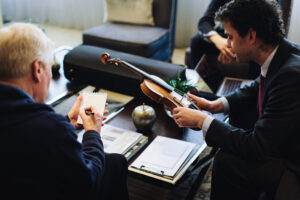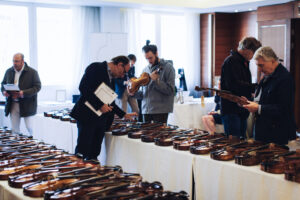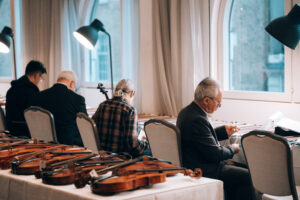Improve your playing with a better instrument

Buying the right instrument can improve your playing considerably, and your enjoyment of it
Buying the right instrument can improve your playing considerably, and your enjoyment of it. Making music is not just about you and your hard work; your violin (or cello, viola, bass, and bow) has to pull its weight as well.
I recently bought a bow at auction
A bit of a risk, because it was sans hair and lapping, so the weight was hard to gauge and ‘try before you buy’ laughably implausible, but I loved the heft of it in my hand; the stick was dark and smooth, with no warp; I knew I had to have it. I sweated through an agonising three hours of sale before managing to triumphantly bag it. And, although the hairline cracks in the handle that I had (ahem) chosen to ignore in my lust for acquisition have since swallowed up several litres of glue, and made me the toast of bow-repairers the length and breadth of three counties, I love it. It floats like a butterfly at the tip and stings like a… Suffice to say, for me, and my technique, it’s a champion. Because, as you well know, that’s the originality and the beauty of this quest: every player has unique physical attributes and needs: ‘each to their own’ has never rung truer.
Small hands?
Great – perhaps a smaller model instrument (particularly if you’re a ‘cellist) will stop you overstraining tendons and missing extensions. A family member battled for years with a big, dark French beast, before exchanging it for a small, tubby, friendly Wamsley which has transformed her enjoyment of playing. Teamed with a Sartory bow, it’s a glorious combination. A friend finally admitted that her beautiful, but small, Rogeri violin was causing hand cramp and elbow pain in the higher reaches (those semitones are just so close together) – it had to go.
Find something with a sound you love.
But are also comfortable playing. There can be no compromises when you’re spending seven hours or so every day with the instrument. Something that niggles a bit at first will become magnified and make you unhappy. Even the weight of an instrument will make a material difference to your comfort.
So, here’s my best advice: take the time to attend the Amati viewing days. Spend plenty of time there. If you’re after a new instrument, take your own bow, and vice versa. Cut down the variables. If possible, try the instrument/bow in a slightly dead acoustic, to see how it sounds without the aid of marble floors and soaring ceilings.
Anything with a sound you love is gold. Anything that irons out technical lumps and bumps, pronating index fingers, awkward spiccato, messy extensions, or your own personal foibles, is your friend for life. Talk to our experts, and feel free to bring a friend, colleague or teacher with you. If you’re not convinced, don’t buy – there will be a right instrument or bow for you another day. If you’re certain, then good luck!




